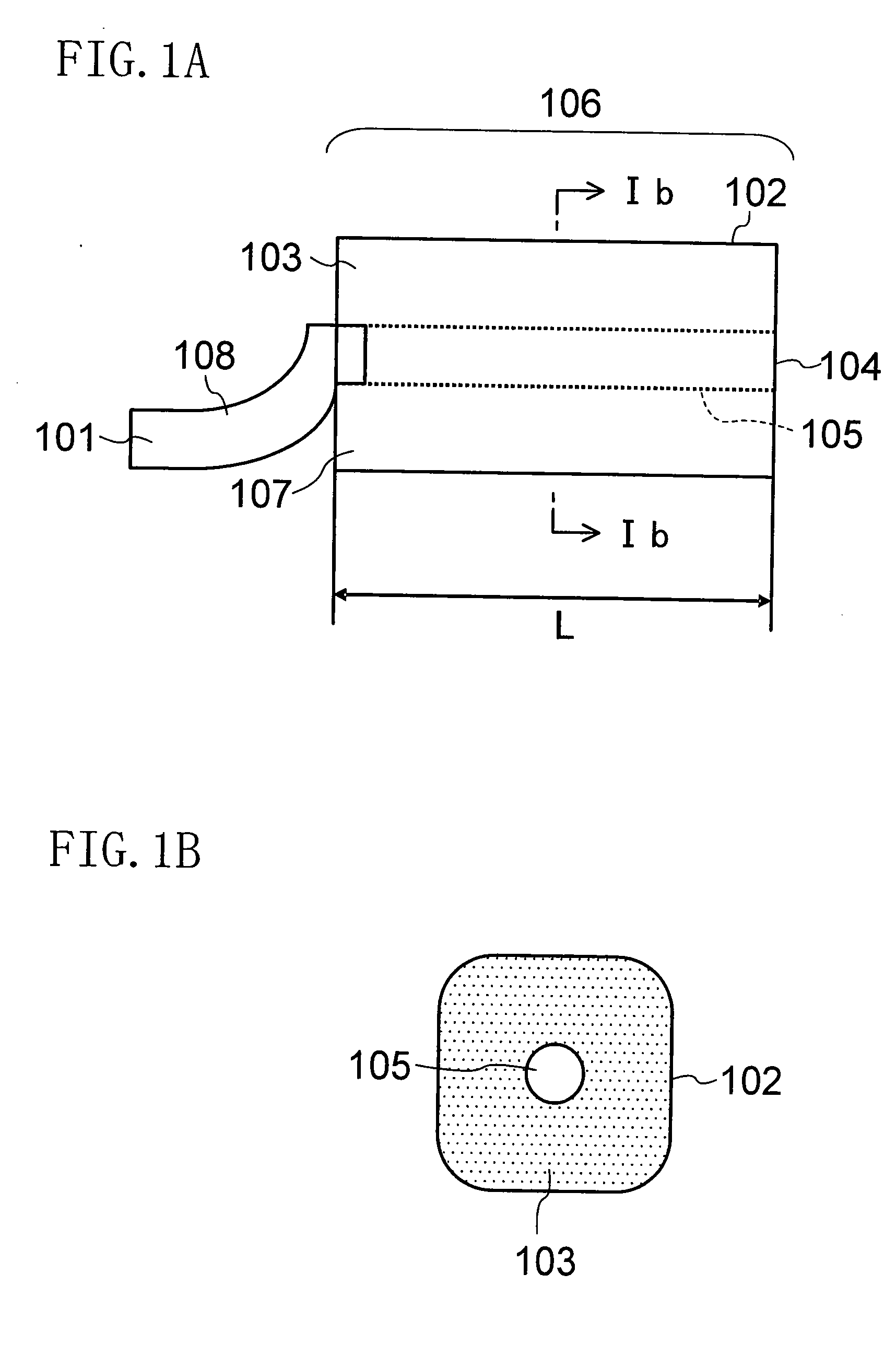High frequency power amplifier and high frequency heating device
a high-frequency power amplifier and heating device technology, applied in amplifiers, amplifiers with semiconductor devices/discharge tubes, amplifiers, etc., can solve the problems of transmission loss inhibiting the reduction of power consumption, the difficulty of reducing the size of the harmonic control circuit composed of microstrip lines, etc., to reduce the transmission loss in the harmonic control circuit and reduce the transmission loss
- Summary
- Abstract
- Description
- Claims
- Application Information
AI Technical Summary
Benefits of technology
Problems solved by technology
Method used
Image
Examples
embodiment 1
[0054]FIG. 1A and FIG. 1B are a side view and a sectional view, respectively, of a dielectric resonator in accordance with the present invention.
[0055]In a dielectric resonator 106, as shown in FIG. 1A and FIG. 1B, a strip line 105 as a signal line is covered with a dielectric material 103 and the dielectric material 103 is covered with a grounded external conductor 102.
[0056]Accordingly, when an electromagnetic wave is input to the strip line 105, the dielectric resonator 106 confines the input electromagnetic wave, so that the dielectric resonator 106 can have excellent resonance characteristics with a Q value of the resonance of 1000 or more.
[0057]In general, the transmission loss in a harmonic control circuit for controlling the harmonics of an input electromagnetic wave is determined according to the Q value of resonance.
[0058]In the present invention, a harmonic control circuit has dielectric resonators with a high Q value of resonance when compared with stubs on a conventiona...
embodiment 2
[0066]FIG. 2 is a circuit diagram of a high frequency power amplifier in accordance with Embodiment 2 of the present invention. The high frequency power amplifier of FIG. 2 includes an amplification element 204, such as a transistor or the like, a harmonic control circuit 209, an output matching circuit 207, and a load resistor 208. Reference numeral 201 denotes an input end of a high frequency signal, 202 denotes a DC bias end for driving the amplification element 204, and 203 denotes a choke inductor for cutting a high frequency.
[0067]The high frequency signal input from the input end 201 is amplified in the amplification element 204, passes through the harmonic control circuit 209 and the output matching circuit 207, and is supplied to the load resistor 208.
[0068]The output matching circuit 207 solves impedance mismatch between the output end of the output matching circuit 207 and the load resistor 208 and usually adjusts the impedance on the amplification element side so as to b...
embodiment 3
[0080]FIG. 3 is a circuit diagram of a high frequency power amplifier in accordance with Embodiment 3 of the present invention. The difference from Embodiment 2 of the present invention lies in that the second dielectric resonator 205 is replaced by a third dielectric resonator 301. Herein, the third dielectric resonator 301 is connected at the one end thereof to the output end of the amplification element 204 via the connection end A and is opened at the other end, and the axial length thereof is adjusted so as to correspond to 3λ / 8.
[0081]As described in Embodiment 2 of the present invention, the first dielectric resonator 206 allows the impedances for the second, sixth, tenth, . . . , 2(2m−1)-th harmonics to be short-circuited.
[0082]Further, with the first and third dielectric resonators 206, 301 of which total axial length corresponds to λ / 2, the fundamental wave forms an amplitude loop at the open end of the first dielectric resonator 206 while forming an amplitude loop at the o...
PUM
 Login to View More
Login to View More Abstract
Description
Claims
Application Information
 Login to View More
Login to View More - R&D
- Intellectual Property
- Life Sciences
- Materials
- Tech Scout
- Unparalleled Data Quality
- Higher Quality Content
- 60% Fewer Hallucinations
Browse by: Latest US Patents, China's latest patents, Technical Efficacy Thesaurus, Application Domain, Technology Topic, Popular Technical Reports.
© 2025 PatSnap. All rights reserved.Legal|Privacy policy|Modern Slavery Act Transparency Statement|Sitemap|About US| Contact US: help@patsnap.com



